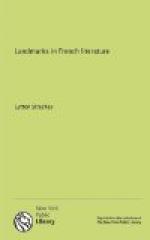The most abiding impression produced by the novels of Flaubert is that of solidity. This is particularly the case with his historical books. The bric-a-brac and fustian of the Romantics has disappeared, to be replaced by a clear, detailed, profound presentment of the life of the past. In Salammbo, ancient Carthage rises up before us, no crazy vision of a picturesque and disordered imagination, but in all the solidity of truth; coloured, not with the glaring contrasts of rhetoric, but with the real blaze of an eastern sun; strange, not with an imported fantastic strangeness manufactured in nineteenth-century Paris, but with the strangeness—so much more mysterious and significant—of the actual, barbaric Past.
The same characteristics appear in Flaubert’s modern novels. Madame Bovary gives us a picture of life in a French provincial town in the middle of the last century—a picture which, with its unemphatic tones, its strong, sensitive, and accurate drawing, its masterly design, produces an effect of absolutely convincing veracity. The character and the fate of the wretched woman who forms the central figure of the story come upon us, amid the grim tepidity of their surroundings, with extraordinary force. Flaubert’s genius does not act in sudden flashes, but by the method of gradual accumulation. The effects which it produces are not of the kind that overwhelm and astonish, but of the more subtle sort that creep into the mind by means of a thousand details, an infinitude of elaborated fibres, and which, once there, are there for ever.




